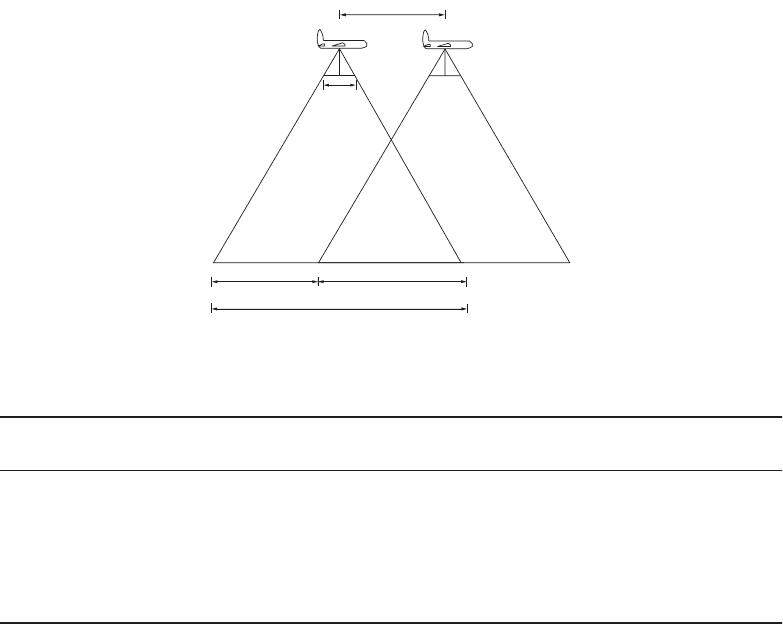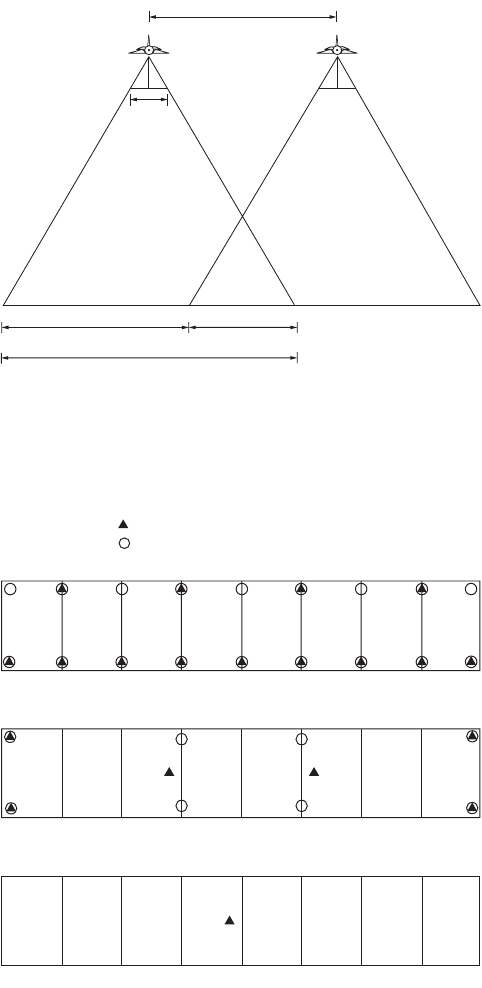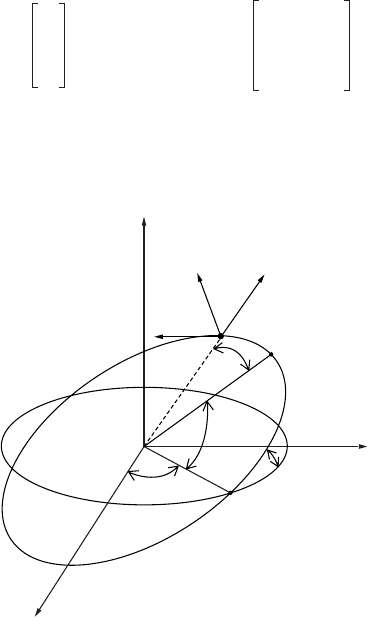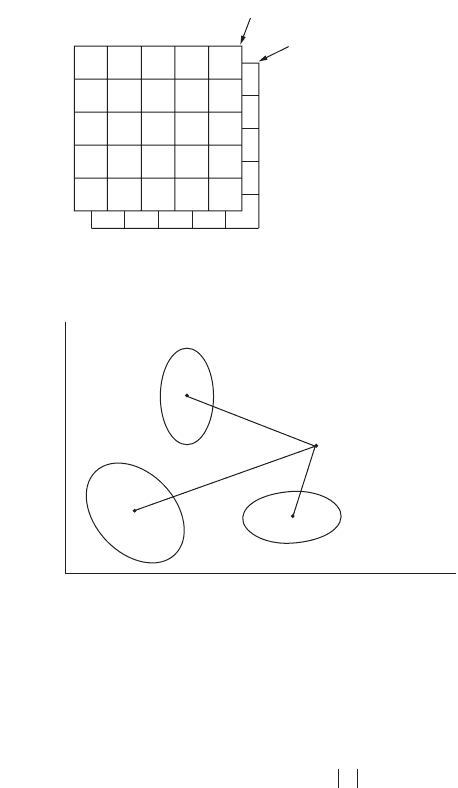Wai-Fah Chen.The Civil Engineering Handbook
Подождите немного. Документ загружается.


56-28 The Civil Engineering Handbook, Second Edition
1. For each photograph, determine two points in object space which lie in the epipolar plane.
2. For each photograph, project the two corresponding points into the photograph plane and solve
for the parameters defining the resulting line in image space.
3. Resample each digital image at an appropriate interval along these lines.
4. Determine a match point interval in image space. Select points in one image at this spacing along
the epipolar line.
5. For each match point in one image, bracket it by some pixels on either side of it. Then search the
epipolar line in the other image for the best match “element.” The match criterion is usually the
above-mentioned cross-correlation function, but it can be any objective function which measures
the degree of “sameness” between the elements.
6. Create in this way an irregularly spaced line of points in object space.
7. Rotate the epipolar plane about the photograph baseline by a small amount, and repeat the process.
This will create an irregular grid of XYZ points in object space.
8. Use these points directly to form a TIN, or interpolate a regular grid as described earlier.
Up to now, digital image matching has been most effective and reliable when used on small and
medium scale imagery. Large scale images, showing the fine structure of the terrain along with individual
trees, buildings, and other man-made objects, may contain steep slopes and vertical planes (i.e., not a
smooth, continuous surface). This generally interferes with the simple matching algorithms described
here. For large scale engineering mapping, more research needs to be done to develop more robust
matching methods.
56.7 Photogrammetric Project Planning
Project planning usually starts with analysis of the specifications for the maps or image products to be
produced. Requirements for these final products generally place fairly rigid constraints on the choices
available to the planner. The constraints arise because the specified accuracies must be achieved and on
the other hand the process must be economical.
Flight Planning
For conventional topographic mapping in the U.S., a compilation system (camera, field survey system,
stereoplotter, operators, etc.) is often characterized by a C-factor, used as follows:
(56.70)
This C-factor can be in the range of 150 to 250 depending on the quality of the equipment and the
skill of the personnel doing the compilation. Thus if one knows from the specifications that a 1-m contour
interval is required and the C-factor is 2000, the maximum flying height (above the terrain) would be
2000 m. One could always be conservative and fly at a lower height, resulting in more photographs at a
larger scale. Table 56.2 gives a series of representative parameters for some of the traditional mapping
scales used in the U.S. Conventional forward overlap between successive photographs is 60%. Conven-
tional side overlap is 30%. In Table 56.2 the enlargement factor is the factor from negative scale to map
scale. Figure 56.16 shows the geometry for determining the base, B, or forward gain, from the ground
dimension of the photograph coverage, W, and the forward overlap as a fraction of W (60% is a common
value). The following equation gives B as described (OL = 0.6, the forward overlap fraction):
(56.71)
The photograph coverage, W, is related to the actual photograph dimension, w, by the scale
(56.72)
Flying height C-factor Contour interval¥=
B 1 OL–()W¥=
W Scale w¥=
© 2003 by CRC Press LLC

Photogrammetry and Remote Sensing 56-29
The photograph dimension, w, is approximately 23 cm for standard aerial film. An analogous situation
is shown in Fig. 56.17 for determining S, the distance between flight lines, from W and from the side
overlap as a fraction of W (30% is a common value). The following equation gives S (SL = 0.3, the side
overlap fraction):
(56.73)
Control Points
Horizontal control points (XY or NE ) allow proper scaling of the model data collected from the stereo
photographs. Vertical control points (Z or h) allow the proper terrain slopes to be preserved. Classical
surveying techniques determined these two classes of control separately and the distinction is still made.
Even with GPS-derived control points, which are inherently 3-D, the elevation or Z-dimension is often
disregarded because we lack an adequate geoid undulation map to convert ellipsoid heights to orthometric
(sea level) referenced heights. Control points may be targeted or signalized before the photo flight so
that they are visible in the images, or one may use photo-ID or natural points such as manhole covers
or sidewalk corners. Coordinates are determined by field survey either before or after the flight, though
usually after in the case of photo-ID points. If artificial targets are used, the center panel (at image scale)
should be modestly larger than the measuring mark in the stereocomparator or plotter. There should
also be two or more prominent legs radiating from the target center panel to allow easy identification in
the photographs. Each stereo model requires an absolute minimum of two horizontal control points and
three vertical control points. These could all be established by field techniques but this would usually be
too expensive. More commonly a sparser network of control points is established, and the needed control
in between the field control is determined by bridging or aerial triangulation. When aerial triangulation
FIGURE 56.16 Forward overlap geometry.
TA BLE 56.2
Typical Flight Parameters (Length Units: Feet)
Map Scale Ratio
Cont.
Intvl. Neg. Scale
Engl.
Factor H C-Factor W Fwd. Gain Flt. Line Spc.
1≤ = 50¢ 600 1 4,200 7 ¥ 2,100 2100 3,150 1,260 2,205
1≤ = 100¢ 1,200 2 7,800 6.5 ¥ 3,900 1950 5,850 2,340 4,095
1≤ = 200¢ 2,400 5 12,000 5 ¥ 6,000 1200 9,000 3,600 6,300
1≤ = 400¢ 4,800 5 16,800 3.5 ¥ 8,400 1680 12,600 5,040 8,820
1≤ = 1000¢ 12,000 10 30,000 2.5 ¥ 15,000 1500 22,500 9,000 15,750
1≤ = 2000¢ 24,000 10 384,000 1.6 ¥ 19,200 1920 28,800 11,520 20,160
1≤ = 4000¢ 48,000 20 57,600 1.2 ¥ 28,800 1440 43,200 17,280 30,240
B
W
B
Foreward Overlap Region
W
S 1 SL–()W¥=
© 2003 by CRC Press LLC

56-30 The Civil Engineering Handbook, Second Edition
is used, artificial marking or pugging of the film diapositives is necessary to create points for the operator
to use for absolute orientation. When GPS is used in the aircraft to determine exposure station coordinates
independently, then in theory, assuming one has photo strips crossing at near right angles, no ground
control is needed. Without crossing strips, at least one control point is necessary. In practice the best
number to use will probably fall between 1 and the larger number necessary for ground control-based
aerial triangulation. These control point requirements are shown in Fig. 56.18.
FIGURE 56.17 Side overlap geometry.
FIGURE 56.18 Control point distributions.
S
w
S
W
Side Overlap Region
=
=
Horizontal Control Point
Vertical Control Point
Full Field Control for Every Model
Field Control for Aerial Triangulation
Field Control for GPS in the Aircraft
© 2003 by CRC Press LLC

Photogrammetry and Remote Sensing 56-31
56.8 Close-Range Metrology
Close range metrology using photogrammetry offers some unique advantages and presents some equally
unique challenges. The advantages are (1) it is a noncontact measurement method, (2) photography can
be acquired relatively quickly in dangerous or contaminated areas, (3) the photographs represent an
archival record in case any dimensions are disputed, and (4) the camera can be brought to the object,
rather than the other way around (as with a coordinate measuring machine). Accuracies obtainable using
close-range photogrammetry (as in aerial photogrammetry) would fall in the range of 1/5,000 to
1/100,000 of the object distance.
Equipment
Cameras are typically small format, usually with 70-mm film size. Stereometric cameras are mounted
rigidly in pairs, so that fewer parameters are required in solving for the orientations. The cameras used
would preferably be metric, although with very special handling, and much extra effort, nonmetric
cameras can be used for some applications. There should be at least some sort of fiducial marks in the
focal plane, preferably a reseau grid covering the image area. Film flatness can be a severe problem in
nonmetric cameras. Ideally there should be a vacuum back permitting the film to be flattened during
exposure. There should be detents in the focus settings to prevent accidental movement or slippage in
the setting. Calibration will be carried out at each of these focus settings, resulting in a set of principal
distances and lens distortion curves for each setting. These are often computed using added parameters
in the bundle adjustment, performed by the user, rather than sending the camera to a testing laboratory.
Lighting can be a problem in close-range photogrammetry. For some objects and surfaces which have
very little detail and texture, some sort of “structured lighting” is used to create a texture. To obtain
strong geometry for the best coordinate accuracy, highly convergent photography is often used. This may
prevent conventional stereo viewing, leading to all photo observations being made in monoscopic view.
This introduces an additional requirement for good targeting, and can make advantageous the use of
feature equations rather than strictly point equations.
Applications
Close-range photogrammetry has been successfully used for tasks such as mapping of complex piping
systems, shape determination for parabolic antennas, mating verification for ship hull sections, architec-
tural/restoration work, accident reconstruction, and numerous medical/dental applications.
56.9 Remote Sensing
Remote sensing is considered here in its broad sense, including the photogrammetric aspects of using
nonframe imagery from spaceborne or airborne platforms. A thorough treatment must include the metric
aspects of the image geometry and the interpretive and statistical aspects of the data available from these
sources.
Data Sources
Following is a partial listing of sensors, with associated platform and image descriptions. These sensors
provide imagery which could be used to support projects in civil engineering.
1. MSS, multispectral scanner, Landsat 1-5, altitude 920 km, rotating mirror, telescope focal length
0.826 m, IFOV (instantaneous field of view) 83 m on the ground, gray levels 64, image width
2700 pixels, 4 spectral bands: 0.4–1.0 micrometers
2. TM, thematic mapper, Landsat 4-5, altitude 705 km, rotating mirror, telescope focal length 1.22 m,
IFOV 30 m on the ground, gray levels 256, image width 6000 pixels, 6 spectral bands: 0.4–0.9, 1.5–1.7,
2.1–2.4, 10.4–12.5 micrometers
© 2003 by CRC Press LLC

56-32 The Civil Engineering Handbook, Second Edition
3. SPOT, SPOT 1-3, panchromatic (multispectral not described), altitude 822 km, pushbroom,
telescope focal length 1.082, IFOV 10 m on the ground, gray levels 256, image width 6000 pixels,
1 panchromatic band 0.55–0.75 micrometers plus 3 multispectral bands, off-nadir viewing capa-
bility for stereo
Geometric Modeling
Coordinate Systems
The two primary coordinate systems needed for describing elliptical orbits as occupied by imaging sensor
platforms are the XYZ system and the q
1
q
2
q
3
system shown in Fig. 56.19. The XYZ system has the XY
plane defined by the earth equatorial plane, Z oriented with the spin axis of the earth, and with X through
the vernal equinox or the first point of Aries. The second system has q
1
q
2
in the orbit plane with origin
at one focus of the ellipse, as shown in Fig. 56.19. q
1
is along the semimajor axis; q
2
q
3
are as described
above to define a right-handed coordinate system.
Orbital Mechanics
The gravitational attraction between the earth and an orbiting satellite is
(56.74)
where m = the mass of the satellite
r = the geocentric distance to the satellite
GM = the earth’s gravitational constant:
For a small mass satellite,
(56.75)
FIGURE 56.19 Orbital parameters.
Z
Satellite
q
1
q
2
q
3
f
i
3
Ω
Y
X
F
GMm
r
2
--------------=
GM 3986004 10
8
m
3
s
2–
¥,,=
m
GMm GMª=
© 2003 by CRC Press LLC

Photogrammetry and Remote Sensing 56-33
Expressing the position vector in 3-D coordinates and the position in the orbital plane in polar
coordinates, extracting an expression for the acceleration, and further manipulating the expressions yields
a differential equation whose solution is a general conic section in polar coordinates:
(56.76)
where f is the true anomaly as shown in Fig. 56.19, p is the semilatus rectum, and e is the eccentricity.
For e > 1 the orbit is a hyperbola, for e = 1 the orbit is a parabola, and for e < 1 the orbit is an ellipse.
The use of the term anomaly as a synonym for angle is a vestige of Ptolemaic misconceptions, originally
implying an angle which did not vary linearly with time. The true anomaly, f, the eccentric anomaly, E,
and the mean anomaly, M, are related by Kepler’s equation:
(56.77)
and
(56.78)
The point on an elliptical orbit furthest from the earth is the apogee; the point closest is the perigee.
At perigee the true anomaly is zero; at apogee it is 180 degrees. An orbit is specified when the satellite
position and velocity vectors, r and
·
r are given at a particular time. A more common set of six parameters
to specify an orbit are the classical Keplerian elements {a, e, T
0
, W, i, and w}, where a is the semimajor
axis, e is the eccentricity, T
0
is the time of perigee passage, W is the right ascension of the ascending node
(shown in Fig. 56.19), i is the inclination, and w is the argument of the perigee.
In order to obtain the Kepler elements from the position and velocity vectors at a given time, the
following equations can be used. The angular momentum vector is
(56.79)
This yields
(56.80)
(56.81)
With v representing the velocity,
(56.82)
(56.83)
r
p
1 ef()cos+
----------------------------=
MEeEsin–=
f
2
--
˯
ʈ
tan
1 e+
1 e–
-----------
E
2
---
˯
ʈ
tan=
h
h
x
h
y
h
z
rr
˙
¥==
W tan
1–
h
x
h
y
–
--------
˯
ʈ
=
i tan
1–
h
x
2
h
y
2
+
h
z
--------------------
˯
Á˜
ʈ
=
a
r
2
rv
2
m
§
()–
----------------------------=
e 1
h
2
m
a
------–=
© 2003 by CRC Press LLC

56-34 The Civil Engineering Handbook, Second Edition
Obtaining the eccentric anomaly from
(56.84)
the true anomaly is found from
(56.85)
Defining an intermediate coordinate system in the orbit plane such that p
1
is along the nodal line,
(56.86)
(56.87)
T
0
can be obtained from
(56.88)
To go in the other direction, from the Kepler elements to the position and velocity vectors, begin with
Eq. (56.88) to obtain the mean anomaly, then solve Kepler’s equation, Eq. (56.77), numerically for the
eccentric anomaly, E. The true anomaly, f, is found by Eq. (56.78). The magnitude of the position vector
in the orbit plane is
(56.89)
the position vector is
(56.90)
and the velocity vector is
(56.91)
where p, the semilatus rectum, is given by
(56.92)
The rotation matrix relating the orbit plane system and the vernal equinox, spin-axis system is given by
Ecos
ar–
ae
----------=
f tan
1–
1 e
2
– Esin
Ee–cos
-----------------------------
˯
ʈ
=
p
p
1
p
2
p
3
R
1
i()R
3
W()r==
w
f+ tan
1–
p
2
p
1
----
˯
ʈ
=
M
m
a
3
---- tT
0
–()=
r
a 1 e
2
–()
1 ef()cos+
----------------------------=
r
q
1
q
2
q
3
˯
Á˜
Á˜
ʈ
rf()cos
rf()sin
0
˯
Á˜
Á˜
ʈ
==
v
m
p
---
f()sin–
ef()cos+
0
˯
Á˜
Á˜
ʈ
=
pa1 e
2
–()=
© 2003 by CRC Press LLC

Photogrammetry and Remote Sensing 56-35
(56.93)
where R is
(56.94)
This R can be used to transform both the position and velocity vectors above into the XYZ “right
ascension” coordinate system defined above.
Platform and Sensor Modeling
If we consider a linear sensor on an orbiting platform, with the sensor oriented such that the long
dimension is perpendicular to the direction of motion (i.e., pushbroom), we can construct the imaging
equations in the following way. Each line of imagery, corresponding to one integration period of the
linear sensor, can be considered a separate perspective image, having only one dimension. Each line
would have its own perspective center and orientation parameters. Thus, what may appear to be a static
image frame is, in fact, a mosaic of many tiny “framelets.” These time dependencies within the image
“frame” are the result of normal platform translational velocity, angular velocity, and additional small,
unpredictable velocity components. The instantaneous position and orientation of a platform coordinate
system is shown in Fig. 56.20.
The equations which relate an object point, (X
m
, Y
m
, Z
m
)
t
, and the time-varying perspective center,
(X
s
(t), Y
s
(t), Z
s
(t))
t
are of the form
(56.95)
R
III
is a platform to sensor rotation matrix which should be fixed during a normal frame. This could
accommodate off-nadir view angle options, for instance. R
II
transforms the ideal platform to the actual
FIGURE 56.20 Imaging satellite orientation.
r
XYZ
Rr
q
1
q
2
q
3
=
RR
3
W–()R
1
i–()R
3
w
–()=
0
y
f–
kR
III
¥ R
II
¥ R
I
X
m
X
s
t()–
Y
m
Y
s
t()–
Z
m
Z
s
t()–
¥¥=
Z
Y
X
z
y
x
f
w
i
Ideal Satellite Platform
Coordinate System
Perigee
Ascending Node
Ω
© 2003 by CRC Press LLC

56-36 The Civil Engineering Handbook, Second Edition
platform and the time dependency in its angles would probably take the form of low degree polynomial
functions. R
I
represents the time-dependent rotation from a space-fixed geocentric coordinate system to
the instantaneous platform coordinate system. In a manner similar to the previous section, this matrix
would be the composition of the rotations,
(56.96)
with the orbit elements as described in the previous section. The Cartesian coordinates on the right side
of Eq. (56.95) are with respect to a space-fixed coordinate system (i.e., not rotating with the earth). In
order to transform a point in a terrestrial, earth-fixed coordinate system, a coordinate rotation, R
0
, is
necessary to account for the earth’s rotation, polar motion, precession, and nutation. For (X
e
, Y
e
, Z
e
)
t
in
an earth-fixed system,
(56.97)
Analogous to the decomposition of conventional orientation in photogrammetry into exterior and
interior components, we could construct here a decomposition of the imaging Eq. (56.95) into a platform
component and a sensor component. Eliminating the nuisance scale parameter in Eq. (56.95) would
yield two equations per object point, per image “frame.” Unknown parameters would consist of a user-
selected subset of the platform and sensor orientation parameters, some time varying, the orbit param-
eters, and the object point parameters. These equation systems could be formed for a single image
(resection), a set of sequential images along the orbit path (strip), or an arbitrary collection of adjacent
frames (block).
The imminent arrival of commercially available satellite data in the 1- to 3-meter pixel range means
that this kind of image modeling will become even more important in the future as digital sensors
continue to slowly supplant film-based photography.
Interpretive Remote Sensing
Remote sensing, as the term is usually employed, implies the study of images to identify the objects and
features in them, rather than merely to determine their size or position. In this way, remote sensing is a
natural successor to the activity described by the slightly outdated and more restrictive term photo
interpretation. Remote sensing almost always implies digital data sources and processing techniques. It
often implies multiple sensors in distinct spectral bands, all simultaneously imaging the same field of
view. Along with the multispectral concept, there is no restriction that sensors respond only within the
range of visible radiation. Indeed, many remote sensing tasks rely on the availability of a wide range of
spectral data. Witness the recent move toward “hyperspectral” data, which may have hundreds of distinct,
though narrow, spectral bands.
Systems have been deployed with sensitivities in the ultraviolet, visible, near infrared, thermal infrared,
and microwave frequencies. Microwave systems are unique in that they can be active (providing source
radiation as well as detection), whereas all of the others listed are strictly passive (detection only). Active
microwave systems include both SLAR, side-looking airborne radar, and synthetic aperture radar.
Multispectral Analysis
Multispectral image data can be thought of as a series of coregistered image planes, each representing
the scene reflectance in a discrete waveband. At each pixel location, the values from the spectral bands
constitute an n-dimensional data vector for that location. Consider an example with two spectral bands
in which the scene has been classified a priori into three categories: water (W), agricultural land (A),
R
I
R
z
p
() R
y
p
2
---
w
– ft()–
˯
ʈ
¥ R
x
i
p
2
---–
˯
ʈ
R
z
W()¥¥=
X
m
Y
m
Z
m
R
0
X
e
Y
e
Z
e
¥=
© 2003 by CRC Press LLC

Photogrammetry and Remote Sensing 56-37
and developed land (D), as shown in Fig. 56.21. From this training sample one can (assuming normality)
construct a mean vector and a variance/covariance matrix for each class. New observation vectors could
then be assigned to one of the defined classes by selecting the minimum of the Mahalanobis function,
(56.98)
where m
i
and S
i
are evaluated for each category. Clustering of feature classes is shown in Fig. 56.22. This
is an example of a maximum likelihood classifier, using supervised classification. Other techniques can
be used such as discriminant functions and Bayesian classification. In addition to statistical and heuristic
approaches to pattern recognition, one can also employ syntactic methods, wherein a feature is identified
by its context or relationship to adjacent or surrounding features.
Change Detection
In order to detect changes on a portion of the earth’s surface it is necessary to have imagery at different
times. In addition, when possible, it is desirable to minimize apparent, but spurious, differences due to
season, view altitude, and time of day. In order to make a proper pixel-by-pixel comparison, both images
should be resampled and brought to the same map projection surface. This is best done by using
identifiable ground control points (road intersections, etc.) and a modeling of the sensor and platform
positions and orientations. Less effective registration is sometimes done using two-dimensional polyno-
mial functions and a “rubber sheet” transformation to the control points. Once the scenes have been
brought to a common coordinate base, a classification is made individually on each scene. A pixel-by-
pixel comparison is made on the classification results, and a “change” layer can be generated where
differences are encountered.
FIGURE 56.21 Training sample for supervised classification.
FIGURE 56.22 Clustering of 2 band data in scatter diagram.
WWW
WWA A A
A
AAAAA
A
A
DDDD
DDDD
A
Band 1
Band 2
W=Water
A=Agriculture
D=Developed
Band 2
Band 1
X
D
D
D
D
D
D
A
A
A
A
A
A
A
A
A
W
W
W
W
W
W
D
2
X
m
i
–()
t
S
i
1–
X
m
i
–()S
i
ln+=
© 2003 by CRC Press LLC
